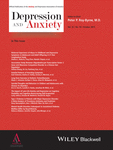LONG-TERM OUTCOME IN PEDIATRIC TRICHOTILLOMANIA
Contract grant sponsor: National Center for Research Resources; Contract grant number: UL1 RR024139.
Trial Registry Name: clinicaltrials.gov
Registry identification number: NCT00993265
Registry URL: http://clinicaltrials.gov/show/NCT00993265
Abstract
Objective
To examine long-term outcome in children with trichotillomania.
Method
We conducted follow-up clinical assessments an average of 2.8 ± 0.8 years after baseline evaluation in 30 of 39 children who previously participated in a randomized, double-blind, placebo-controlled trial of N-acetylcysteine (NAC) for pediatric trichotillomania. Our primary outcome was change in hairpulling severity on the Massachusetts General HospitalHairpulling Hospital Hairpulling Scale (MGH-HPS) between the end of the acute phase and follow-up evaluation. We also obtained secondary measures examining styles of hairpulling, comorbid anxiety and depressive symptoms, as well as continued treatment utilization. We examined both correlates and predictors of outcome (change in MGH-HPS score) using linear regression.
Results
None of the participants continued to take NAC at the time of follow-up assessment. No significant changes in hairpulling severity were reported over the follow-up period. Subjects reported significantly increased anxiety and depressive symptoms but improvement in automatic pulling symptoms. Increased hairpulling symptoms during the follow-up period were associated with increased depression and anxiety symptoms and increased focused pulling. Older age and greater focused pulling at baseline assessment were associated with poor long-term prognosis.
Conclusions
Our findings suggest that few children with trichotillomania experience a significant improvement in trichotillomania symptoms if behavioral treatments are inaccessible or have failed to produce adequate symptom relief. Our findings also confirm results of previous cross-sectional studies that suggest an increased risk of depression and anxiety symptoms with age in pediatric trichotillomania. Increased focused pulling and older age among children with trichotillomania symptoms may be associated with poorer long-term prognosis.




